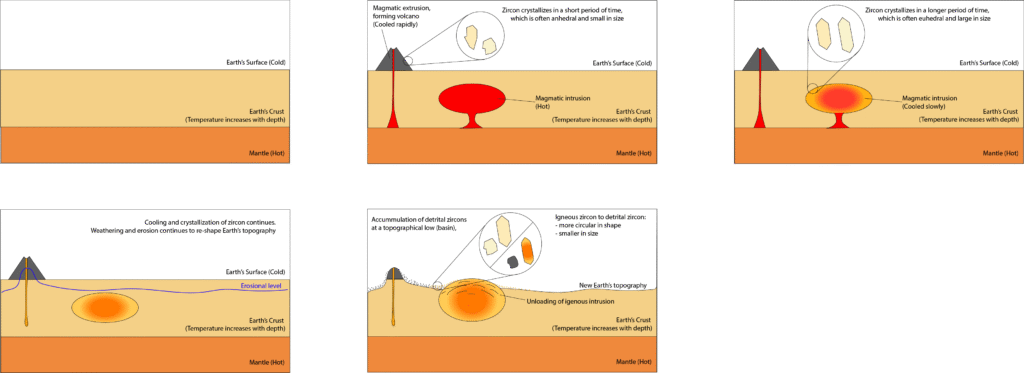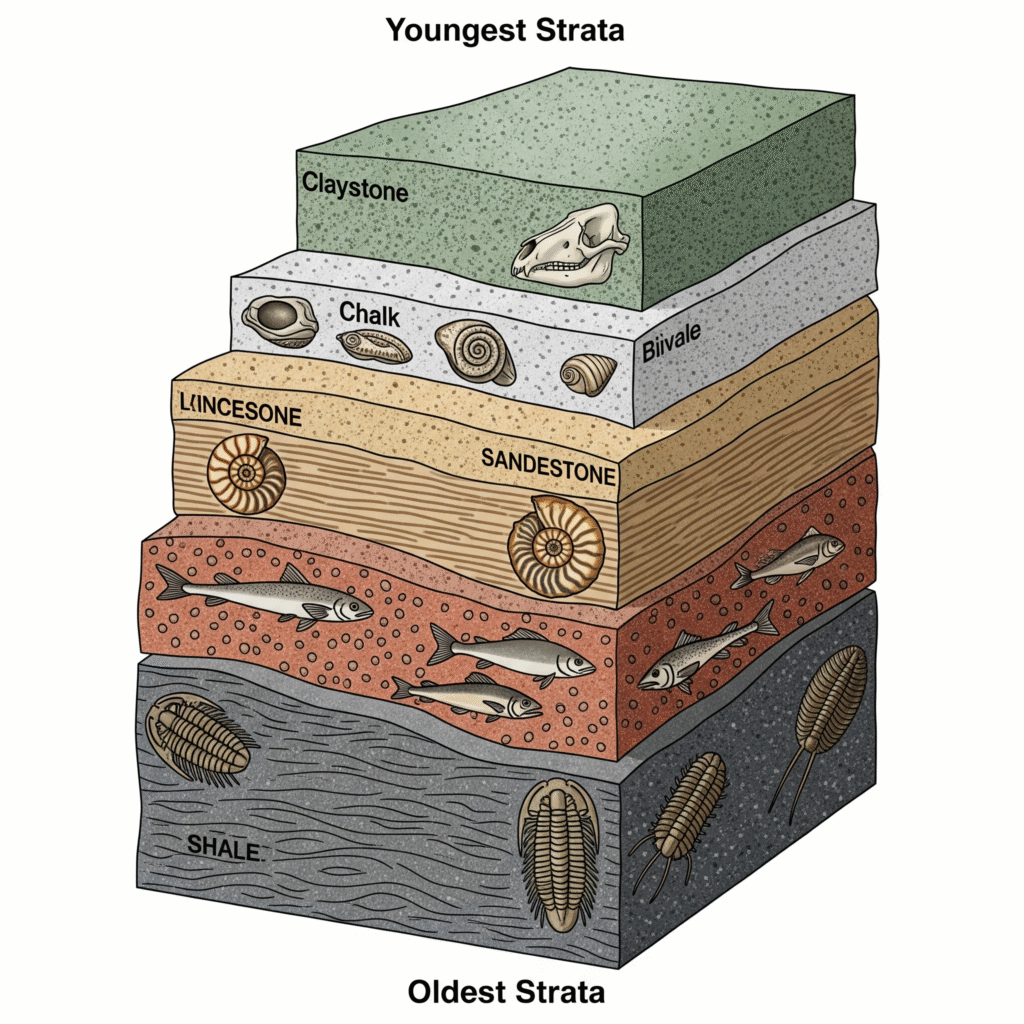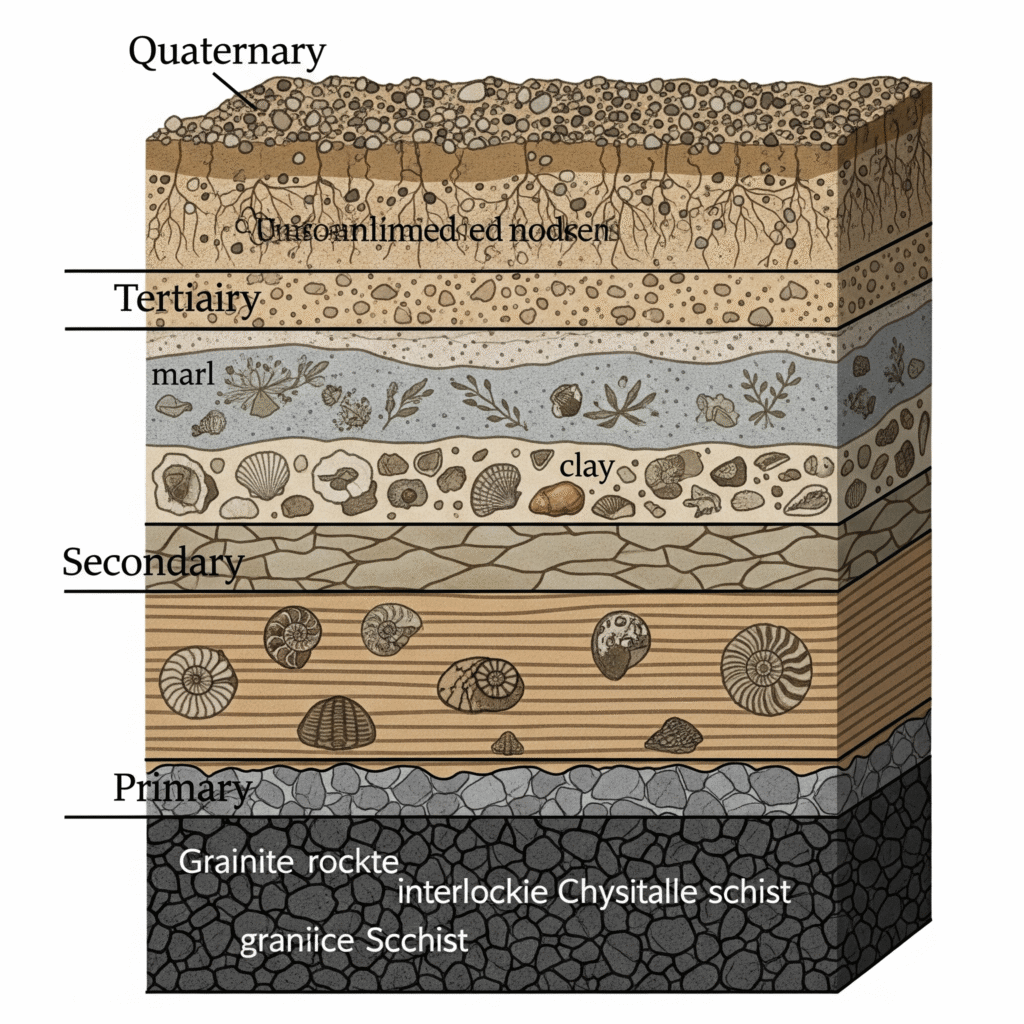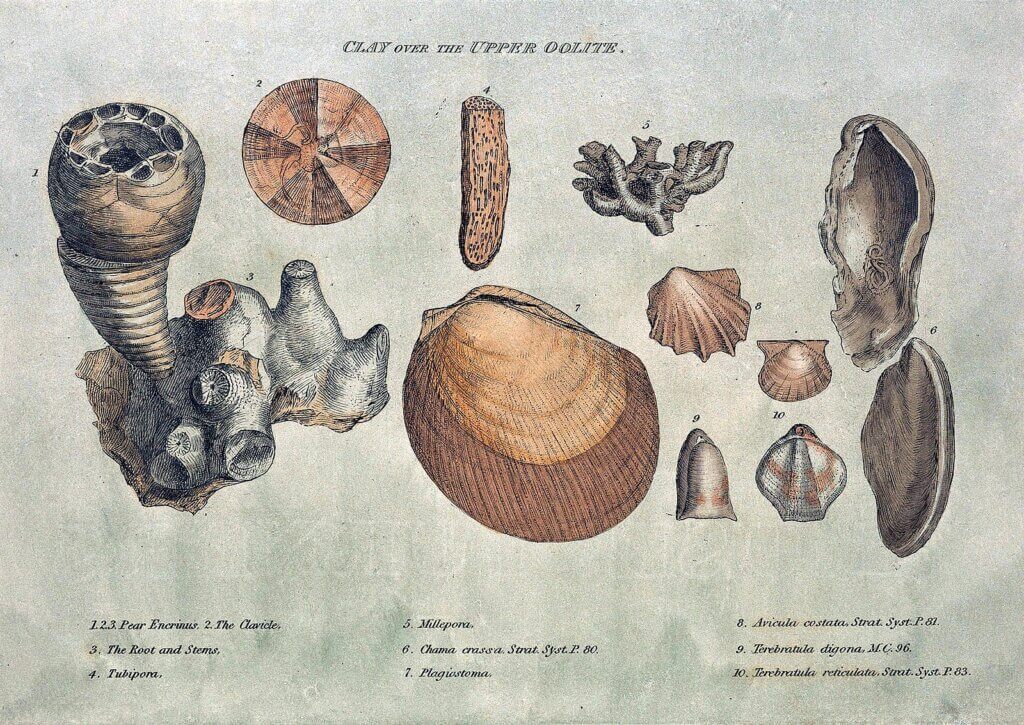The Geologic Time Scale (GTS) is a system of chronological dating that relates geological strata (stratigraphy) to time. Earth scientists use it to describe the timing and relationships of events that have occurred throughout our planet’s history. The GTS organises Earth’s 4.54-billion-year history into a hierarchical set of time intervals, from the largest Eons down to the smallest Ages.
The GTS is built upon two core principles:
- Stratigraphy: The study of rock layers, or strata. The Law of Superposition which states that in an undisturbed sequence of sedimentary rocks, the oldest layers are at the bottom and the youngest are at the top.
- Faunal Succession: Specific fossils are found only in particular rock layers, and the sequence of these fossils is consistent across different locations. This allowed scientists to correlate rock layers from around the world and create a global, relative timeline.
International Commission on Stratigraphy (ICS)
The International Commission on Stratigraphy (ICS) is the largest and most permanent scientific body within the International Union of Geological Sciences (IUGS), and its primary function is to define and formalise the global standard for the GTS. The ICS works to establish a consistent, worldwide framework for stratigraphy by setting the official names, boundaries, and dates for all the time intervals on the GTS. This ensures that geologists, palaeontologists, and other scientists around the world can communicate about Earth’s history using a shared and precise language, preventing confusion and allowing for accurate correlation of rock layers and events across different continents.

“No vestige of a beginning, no prospect of an end”.
– James Hutton
This famous quote from James Hutton, the “Father of Modern Geology,” perfectly encapsulates the challenging nature of understanding Earth’s history. For centuries, scientists have grappled with the age of our planet and the sequence of events that have shaped it. While early concepts ranged from religious beliefs to calculations based on oceanic salinity or erosion, the development of modern scientific methods has led to the comprehensive framework we use today: the Geologic Time Scale (GTS).
Early Concepts of Estimating Earth’s Age
Before the advent of modern dating techniques, various methods were used to estimate Earth’s age, with widely different results:
- Religious Concepts: Ancient texts like the Bible and the Vedas offered explanations for Earth’s origin, often based on mythological timelines.
- Oceanic Salinity: Based on the formula \(\text{Age of Oceans} = \frac{\text{Total Oceanic Salt}}{\text{Annual Rate of Oceanic Salinity}}\)
- Sedimentation: Estimated using: \(\text{Age of Sedimentary Rocks} = \frac{\text{Total Thickness of Sedimentary Strata}}{\text{Annual Rate of Deposition}}\)
- Erosion: Calculations are made by observing rates of erosion of rock layers.
- Tidal Force of the Moon: The rotational force of Earth is reduced due to tidal friction with the moon. The moon is moving away from Earth at ~13 cm/year. Present distance: 384,000 km. Back-calculations suggest that the Earth is approximately 4.5 billion years old. \(\text{Age of Earth} = \frac{\text{Distance of the Moon from Earth}}{\text{Annual Rate of Recession of the Moon}}\)
- Concept of Lord Kelvin: The estimated Earth age is based on the cooling rate of the Earth (1°C per 32 m depth).
- Radioactive Elements (Most Accurate): Radioactive decay produces heat after disintegration. Discovered by Pierre Curie in 1903.

The Birth of Stratigraphy
The foundation of the GTS is built on stratigraphy, the study of rock layers (strata). It’s the principle that forms the basis for relative dating—determining the sequence of events without knowing their exact age.

Nicolas Steno (1669): Steno laid down the first principles of stratigraphy, including the Law of Superposition, which states that in an undeformed sequence of sedimentary rocks, the oldest strata lie at the bottom and the youngest at the top.

Giovanni Arduino (1760s): Arduino began to name the different rock layers he observed in the Alps, dividing them into Primary, Secondary, Tertiary, and Quaternary. While his divisions were a key step, they couldn’t be universally applied to rock sequences in other regions.
The key breakthrough came with the work of an English engineer and geologist, William Smith.

William Smith (1819): While supervising the excavation of canals across England, Smith made a revolutionary observation: the same rock layers always contained the same specific fossils. He also noted that these fossil sequences were consistent across different locations. This led him to formulate the Law of Faunal Succession. This law became the basis for correlation, allowing geologists to match rock layers from different parts of the country—and eventually the world—by identifying the characteristic fossils within them.
Law of Faunal Succession states that…
- Fossil organisms succeed one another in a definite and recognisable order, so that any layer (stratum) of rock contains fossils that can be used to identify and correlate it with other layers of the same age, even across wide geographic areas.
- Fossil species appear, evolve, and go extinct in a predictable sequence through geological time.
- The same succession of fossil assemblages can be recognised in different locations, allowing geologists to correlate rock layers worldwide.
- Example: Trilobites are found in older Palaeozoic rocks, dinosaurs in Mesozoic rocks, and mammals in Cenozoic rocks—never mixed together.
This law provided a sound basis for creating a global, relative timeline. Smith’s work established that fossils were not just random occurrences but markers of specific time periods. However, the reason why this succession of fossils existed remained a mystery until Charles Darwin proposed his theory of evolution by natural selection in his 1859 book, On the Origin of Species. Darwin’s work provided the scientific explanation for the progressive changes observed in the fossil record, linking the geologic sequence to the biological evolution of life on Earth.
The Timescale
The GTS is structured into a hierarchy, with each level representing a different magnitude of time:
To manage the immense span of Earth’s history, the geologic time scale employs a hierarchical system, subdividing time into progressively smaller, more manageable units. These divisions are not arbitrary; they are primarily based on fundamental changes observed in the stratigraphy, often corresponding to major geological or paleontological events.

Eons: The largest divisions of time, spanning hundreds of millions to billions of years. Earth’s history is divided into two main eons: the Precambrian (a Super Eon) and the Phanerozoic. After subdivision of the Precambrian, four formally defined eons encompass Earth’s entire history: the Hadean, Archean, Proterozoic, and Phanerozoic. The Hadean, while considered an “informal” division in some contexts, is crucial as it covers Earth’s very beginning.

Each eon is further subdivided into eras, which are then broken down into periods, followed by epochs, and finally ages, which represent the smallest formal hierarchical units of geologic time. For example, the Phanerozoic Eon, which covers the last 541 million years and the flourishing of complex life, is famously divided into the Palaeozoic, Mesozoic (the age of dinosaurs), and Cenozoic (the age of mammals) Eras. While this report primarily focuses on the abstract
| Unit | Typical Time Span | Description/Significance |
| Eon | 0.5 billion years or more | Largest unit, defines major stages of Earth’s evolution |
| Era | Several hundred million years | Second largest, often marked by significant changes in life and geology |
| Period | Tens to several hundred million years | Subdivides eras, characterized by distinct fossil assemblages or geological events |
| Epoch | Tens of millions of years | Finer divisions within periods, often reflecting more detailed climatic or evolutionary changes |
| Age | Millions of years | Smallest formal unit, provides the most granular detail of geological time |
time units (geochronologic), it is important to note that these correspond to specific rock units (chronostratigraphic units) that represent those time intervals. The International Commission on Stratigraphy is responsible for precisely defining these global units.